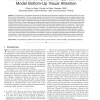Free Online Productivity Tools
i2Speak
i2Symbol
i2OCR
iTex2Img
iWeb2Print
iWeb2Shot
i2Type
iPdf2Split
iPdf2Merge
i2Bopomofo
i2Arabic
i2Style
i2Image
i2PDF
iLatex2Rtf
Sci2ools
PAMI
2006
2006
A Coherent Computational Approach to Model Bottom-Up Visual Attention
Visual attention is a mechanism which filters out redundant visual information and detects the most relevant parts of our visual field. Automatic determination of the most visually relevant areas would be useful in many applications such as image and video coding, watermarking, video browsing, and quality assessment. Many research groups are currently investigating computational modeling of the visual attention system. The first published computational models have been based on some basic and well-understood Human Visual System (HVS) properties. These models feature a single perceptual layer that simulates only one aspect of the visual system. More recent models integrate complex features of the HVS and simulate hierarchical perceptual representation of the visual input. The bottom-up mechanism is the most occurring feature found in modern models. This mechanism refers to involuntary attention (i.e., salient spatial visual features that effortlessly or involuntary attract our attention...
PAMI 2006 | Visual | Visual Attention | Visual System |
| Added | 14 Dec 2010 |
| Updated | 14 Dec 2010 |
| Type | Journal |
| Year | 2006 |
| Where | PAMI |
| Authors | Olivier Le Meur, Patrick Le Callet, Dominique Barba, Dominique Thoreau |
Comments (0)

